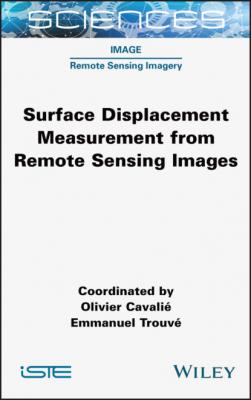Surface Displacement Measurement from Remote Sensing Images. Olivier Cavalie
Читать онлайн.| Название | Surface Displacement Measurement from Remote Sensing Images |
|---|---|
| Автор произведения | Olivier Cavalie |
| Жанр | География |
| Серия | |
| Издательство | География |
| Год выпуска | 0 |
| isbn | 9781119986836 |
Table of Contents
1 Cover
4 Preface
5 PART 1: Theory, Principles and Methodology
6 1 Relevant Past, On-going and Future Space Missions 1.1. Some key parameters for space missions 1.2. Past and on-going SAR missions 1.3. Future SAR missions 1.4. Optical imaging missions 1.5. Conclusion 1.6. Acknowledgments 1.7. References
7 2 Image Matching and Optical Sensors 2.1. Introduction, definition and applications 2.2. Template matching 2.3. Handling “large” deformations 2.4. Discrete nature of the image and sub-pixel matching 2.5. Optical imaging sensors 2.6. Acknowledgments 2.7. References
8 3 SAR Offset Tracking 3.1. Basics of SAR imaging 3.2. SAR offset tracking 3.3. Acknowledgments 3.4. References
9 4 SAR Interferometry: Principles and Processing 4.1. Introduction 4.2. Principle and limits of SAR interferometry 4.3. Atmospheric corrections 4.4. InSAR processing chains 4.5. Conclusion 4.6. Acknowledgments 4.7. References
10 5 Advanced Methods for Time-series InSAR 5.1. Introduction 5.2. Background of time-series InSAR analysis 5.3. A review 5.4. The SBAS technique 5.5. The PSDS technique 5.6. Acknowledgments 5.7. References
11 6 The Interferometric Phase: Unwrapping and Closure Phase 6.1. Introduction 6.2. Phase unwrapping algorithms and limitation of phase unwrapping errors 6.3. The (re)discovery of closure phases and their implications for SAR interferometry 6.4. Acknowledgments 6.5. References
12 PART 2: Applications for Surface Displacements
13 7 Remote Sensing of the Earthquake Deformation Cycle 7.1. Introduction 7.2. What have we learned about faults from nearly three decades of tectonic InSAR? 7.3. Investigating earthquake surface ruptures with optical image correlation 7.4. Conclusion 7.5. Acknowledgments 7.6. References
14 8 Volcanology: The Crucial Contribution of Surface Displacement Measurements from Space for Understanding and Monitoring Volcanoes 8.1. Introduction 8.2. Origin of surface displacement and topographic changes in a volcano 8.3. Techniques used to measure displacements and topographic changes in volcanoes 8.4. Main limitations of measurements obtained by remote sensing 8.5. Main contributions of spatial geodesy for monitoring and studying volcanoes 8.6. Recent progress 8.7. Volcanic crisis management: the contribution of displacement measurements obtained using spatial imagery 8.8. Conclusion 8.9. Acknowledgments 8.10. References
